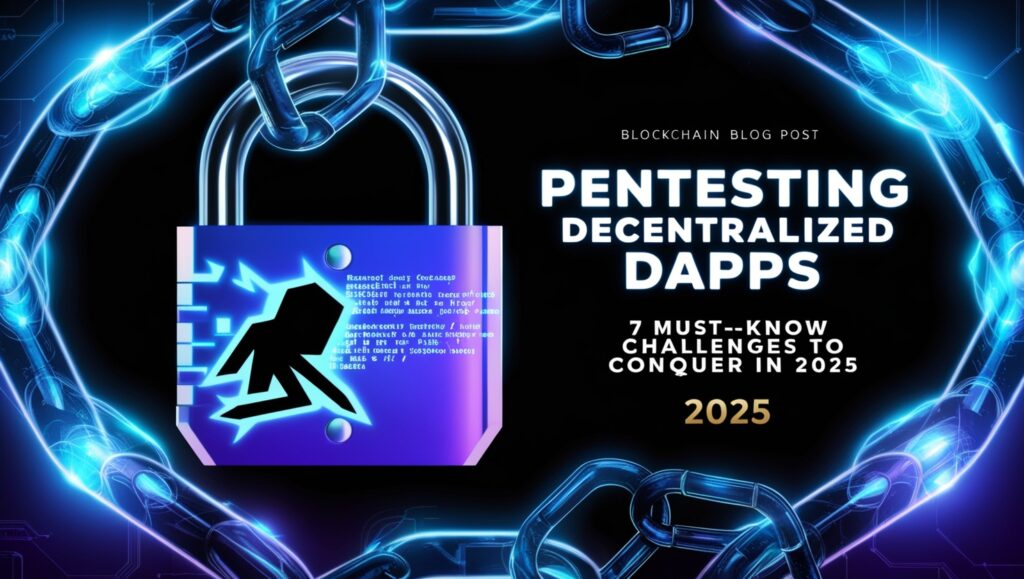1. Introduction: Why Pentesting DApps is the Next Big Thing
The blockchain revolution is here, and decentralized applications (DApps) are leading the charge. From decentralized finance platforms to NFT marketplaces, DApps are transforming how we interact online. But with great innovation comes great risk—hackers are circling. That’s why Pentesting Decentralized Apps is the hottest topic in cybersecurity today. By 2025, these apps will handle billions in transactions, making them prime targets. Traditional pentesting—focused on servers and databases—doesn’t fit this decentralized world. We need a new playbook. In this blog, we’ll explore why DApp pentesting is critical, what makes it unique, and how you can stay ahead in this fast-evolving field. Buckle up—security’s future starts here.

2. Understanding Decentralized Apps: A Quick Primer
Before diving into pentesting, let’s get the basics down. DApps are applications built on blockchain networks like Ethereum, Binance Smart Chain, or Solana. They rely on smart contracts—self-executing code that runs without intermediaries. Picture a vending machine: insert a coin (or crypto), and it delivers without a cashier. Examples? Uniswap lets you swap tokens peer-to-peer, while Axie Infinity blends gaming with blockchain rewards. Unlike traditional apps with a central server, DApps are spread across thousands of nodes. This decentralization boosts resilience but complicates security. Knowing this structure is step one to mastering DApp pentesting.
3. Unique Security Challenges in DApps
Pentesting DApps isn’t like testing a website—blockchain flips the script. First, smart contracts are immutable. Deploy a buggy contract? You’re stuck—there’s no “update” button. Second, the blockchain’s transparency is a double-edged sword. Your code is public, so hackers can dissect it at leisure. Third, there’s no central authority to bail you out. If a hacker exploits a flaw and drains funds, good luck reversing it. Add in the complexity of interacting with external systems (like price feeds), and you’ve got a pentester’s nightmare. These challenges demand a fresh approach—DApps aren’t just apps; they’re ecosystems.
4. Top Vulnerabilities to Target in DApp Pentesting
When you’re pentesting DApps, zero in on these weak spots:
- Reentrancy Attacks: A hacker calls a function repeatedly before it finishes, siphoning funds—like The DAO’s $50M disaster.
- Front-End Manipulation: The shiny UI might trick users into approving malicious transactions.
- Oracle Vulnerabilities: DApps pull real-world data (e.g., crypto prices) via oracles; if tampered, chaos ensues.
- Logic Errors: Simple typos—like an integer overflow—can unlock unintended access.
Spotting these takes skill. Each layer—code, interface, dependencies—hides potential traps. Test them all.
5. Tools and Techniques for Pentesting DApps
You’ll need a solid arsenal for DApp pentesting. Tools like Mythril scan smart contracts for bugs, while Slither digs into code structure. Echidna throws random inputs (fuzzing) to expose cracks. Manual review is king too—automation misses nuance. Techniques? Simulate fake transactions to trick contracts, or flood the system with calls to test gas limits. Combine these for a full assault. The goal isn’t just to find flaws—it’s to think like a hacker and beat them to the punch.
6. Real-World Examples: DApp Hacks and Lessons Learned
History is a brutal teacher. The DAO hack (2016) saw $50M stolen via reentrancy—pentesting could’ve flagged it. Poly Network’s 2021 breach lost $600M (later returned) due to poor key management. Pancake Bunny’s $45M flash loan exploit? A logic flaw in the contract. Each case shows where pentesting matters: contract audits, input validation, and external checks. These hacks weren’t invincible—better testing could’ve stopped them. Learn from the past, or repeat it.
7. The Pentester’s Playbook: Steps to Secure a DApp
Here’s how to pentest a DApp like a pro:
- Audit Smart Contracts: Line-by-line, hunt for bugs—reentrancy, overflows, anything.
- Test Blockchain Interactions: Fake transactions, spoofed calls—see what breaks.
- Probe Off-Chain Parts: Front-end, oracles—test every link in the chain.
- Stress the System: High loads, gas spikes—push it to collapse.
- Validate Fixes: Retest after patches. No shortcuts.
This playbook—Pentesting Decentralized Apps—is your shield. Follow it, and you’ll catch what others miss.
8. The Future of DApp Security in 2025 and Beyond
By 2025, DApps will dominate DeFi, gaming, and more—billions will flow through them. Hackers will weaponize AI to find flaws faster. Pentesting will evolve: AI-driven tools will scan contracts, but human insight will stay key. Regulations might force stricter security—think GDPR for blockchain. DApps in voting or healthcare will raise the stakes. Pentesters who adapt—learning blockchain, mastering new tools—will lead. The future’s bright, but only if we secure it first.
9. Conclusion: Stepping Up to the DApp Security Challenge
DApps are rewriting the rules, and pentesting is their lifeline. From smart contract quirks to billion-dollar hacks, the challenges are real—but so are the solutions. Whether you’re a coder, pentester, or blockchain fan, this is your call to action. Dive into DApp pentesting—learn the tools, study the hacks, and build a safer decentralized world. The clock’s ticking—2025 is coming fast.
10. FAQ Section
- Why is DApp pentesting hard? Immutability—no fixing live contracts.
- What skills do I need? Coding (Solidity), security basics—blockchain’s a bonus.
- Are DApps safer than apps? Sometimes—decentralization cuts risks but adds new ones.
- Best tool for beginners? Try Mythril—simple yet powerful.
Got more? Drop them below!

Leave a Reply